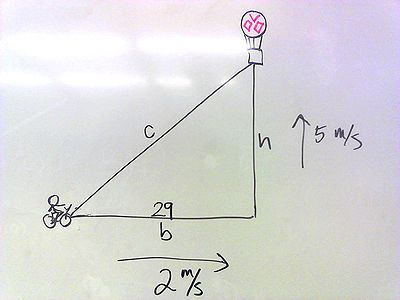Science:Math Exam Resources/Courses/MATH102/December 2012/Question C 05 1
{{#incat:MER QGQ flag|{{#incat:MER QGH flag|{{#incat:MER QGS flag|}}}}}}
• QA 1 • QA 2 • QA 3 • QB 1 • QB 2 • QB 3 • QB 4 • QB 5 • QB 6 • QC 1 • QC 2 • QC 3(a) • QC 3(b) • QC 3(c) • QC 4(a) • QC 4(b) • QC 4(c) • QC 51 • QC 52 •
Question C 05 1 |
|---|
|
Choose ONE of the next two problems (C.5.1 or C.5.2). A hot air balloon with a basket hanging below it is released from the ground and rises straight up at a speed of 5 meters per second. At the moment the balloon is released, a girl is 29 meters from the point on the ground directly below the balloon and is riding her bicycle toward the balloon at a speed of 2 meters per second. From the perspective of the girl, at what time t is the angle between the ground and the basket hanging below the balloon changing most quickly? |
|
Make sure you understand the problem fully: What is the question asking you to do? Are there specific conditions or constraints that you should take note of? How will you know if your answer is correct from your work only? Can you rephrase the question in your own words in a way that makes sense to you? |
|
If you are stuck, check the hints below. Read the first one and consider it for a while. Does it give you a new idea on how to approach the problem? If so, try it! If after a while you are still stuck, go for the next hint. |
Hint 1 |
|---|
|
Try drawing a picture relating all the data given. What mathematical formula relates these pieces? |
Hint 2 |
|---|
|
This is an optimization question. Read carefully: what is being optimized here? |
Hint 3 |
|---|
|
This question is asking to you optimize the rate that is changing, or . So you first need to find an expression for and *then* find its maximum by differentiating/finding critical points. |
Hint 4 |
|---|
|
In order to find the expression for , after differentiating an equation containing , you will need to use the fact that is equal to the hypotenuse over the side adjacent the angle. |
|
Checking a solution serves two purposes: helping you if, after having used all the hints, you still are stuck on the problem; or if you have solved the problem and would like to check your work.
|
Solution | ||||||||
|---|---|---|---|---|---|---|---|---|
|
We will start by drawing a picture relating the different facts given in the problem. Now it is necessary to figure out what the question is asking. This is an optimization problem, where the thing being optimized is the rate at which is changing, or . So our next step is to actually find an expression for this rate. We start by relating all the information we already have in the question. The diagram shows a right triangle, with adjacent and opposite sides labeled. Thus, the best way to relate the information is the tangent function.
We can express the height of the balloon as a function of time. Since it is rising at a rate of 5 m/s, the height of the balloon can be given as . Similarly, the distance of the girl from the ballon's liftoff point can be given as the initial distance, minus her rate of travel, or . Plugging these into the formula, we get:
Differentiating with respect to time (t) gives:
We want our final expression to be in terms of , so we want to change the into an expression in terms of t. We will do this by going back to the definition of as a trig ratio. We recall is the ratio of hypotenuse over adjacent, or in our notation. In particular, we have . The adjacent side b is given by and we can use the Pythagorean theorem to find the hypotenuse .
So we have
Replacing in our original equation, we get:
We want to solve this expression for . Simplifying the above expression, we get:
Now we finally have an expression for . To complete the problem, we must find where it is at a maximum. To do so, we will use our usual method for finding a maximum: differentiating, finding critical points, and testing whether it is a maximum. Taking the derivative gives with respect to t gives:
We are free to ignore the denominator, as it is always positive, thus never makes the derivative undefined. We can therefore restrict our attention to the numerator, set it equal to zero, and solve for t. This gives . It remains to show that this point is a maximum. The easiest way to do this is the first derivative test; that is choosing two points on either side of our critical point and checking if the sign of the derivative changes. Again, the denominator of the derivative is always positive, so we need only consider the numerator:
This indicates that the original rate changes from increasing to decreasing at , meaning that it is indeed the maximum we're looking for. The time at which the angle is increasing the fastest is at seconds after the balloon is released. |
{{#incat:MER CT flag||
}}























